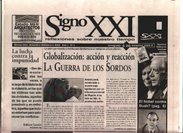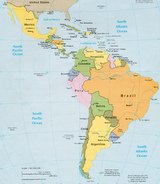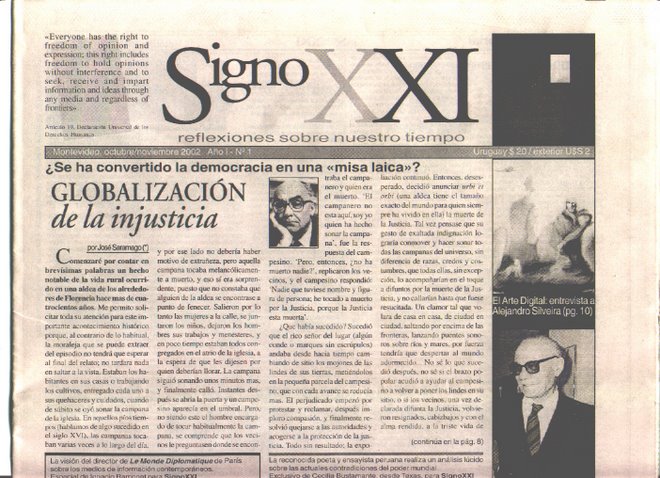A Little Laptop With Big Ambitions
How a Computer for the Poor
Got Stomped by Tech Giants
By STEVE STECKLOW and JAMES BANDLER
November 24, 2007
Cambridge, Mass.
In 2005, Nicholas Negroponte unveiled an idea for bridging the technology divide between rich nations and the developing world. It was captivating in its utter simplicity: design a $100 laptop and, within four years, get it into the hands of up to 150 million of the world's poorest schoolchildren.
![[Nicholas Negroponte]](http://s.wsj.net/public/resources/images/HC-GG054_Negrop_20051014184132.gif)
World leaders and corporate benefactors jumped in to support the nonprofit project, called One Laptop Per Child. Mr. Negroponte, a professor on leave from the Massachusetts Institute of Technology, hopscotched the world collecting pledges from developing nations to buy the laptops in bulk.
But nearly three years later, only about 2,000 students in pilot programs have received computers from the One Laptop project. An order from Uruguay for 100,000 machines appears to be the only solid deal to date with a country, although Mr. Negroponte says he's on the verge of sealing an order from Peru for 250,000. The first mass-production run, which began this month in China, is for 300,000 laptops, tens of thousands of which are slated to go to U.S. consumers. Mr. Negroponte's goal of 150 million users by the end of 2008 looks unattainable.
Mr. Negroponte's ambitious plan has been derailed, in part, by the power of his idea. For-profit companies threatened by the projected $100 price tag set off at a sprint to develop their own dirt-cheap machines, plunging Mr. Negroponte into unexpected competition against well-known brands such as Intel Corp. and Microsoft Corp.'s Windows operating system.
A version of Mr. Negroponte's vision is starting to come true. Impoverished countries are indeed snapping up cheap laptops for their schoolchildren -- just not anywhere near as many of his as he expected. They now have several cut-price models to choose from, raising the possibility that One Laptop Per Child, or OLPC, will end up as a niche player.
|
| Nicholas Negroponte's One Laptop Per Child project sought to get $100 laptops into the hands of millions of the world's poorest schoolchildren. But for-profit versions of the laptop are competing fiercely in the developing world. |
"I'm not good at selling laptops," Mr. Negroponte has told colleagues. "I'm good at selling ideas."
"From my point of view, if the world were to have 30 million" laptops made by competitors "in the hands of children at the end of next year, that to me would be a great success," he said in a recent interview. "My goal is not selling laptops. OLPC is not in the laptop business. It's in the education business."
From its inception, One Laptop Per Child posed a threat to the personal-computing dominance of software giant Microsoft and chip maker Intel. Mr. Negroponte's team, drawn from MIT, designed a machine that didn't use Windows or Intel chips. It uses the Linux operating system and other nonproprietary, open-source software, which users are allowed to tinker with.
Last year, Intel, which normally doesn't sell computers, introduced a small laptop for developing countries called the Classmate, which currently goes for between $230 and $300. It has marketed the computer aggressively, although it stands to make little money on the initiative. But it hopes to prevent rival Advanced Micro Devices Inc., or AMD, whose chips are in Mr. Negroponte's competing computer, from becoming a standard in the developing world.
By most accounts, Mr. Negroponte and his 20-member team have created a rugged, innovative laptop with good software for learning. The small green-and-white device is designed to operate on very little power -- a small solar panel can keep it going -- and to resist rain and dust. Its unique, high-resolution screen stays bright even in direct sunlight. The laptop has a built-in video camera and connects wirelessly to the Internet and to other laptops of its kind.
But the project has hit snags. The $100 price target is proving difficult to hit, although Mr. Negroponte's team has succeeded in creating a device that's cheaper than other laptops. It now sells for $188, plus shipping. Potential buyers in the developing world have expressed concern about the availability of training for schoolteachers, and after-sales support. Mr. Negroponte's plan is for the machines to be simple enough that students can train themselves -- and solve any glitches that arise.
Some potential buyers are having second thoughts about One Laptop Per Child. Officials in Libya, who had planned to buy up to 1.2 million of the laptops, became concerned that the machines lacked Windows, and that service, teacher training and future upgrades might become a problem.
"The Intel machine is a lot better than the OLPC," says Mohamed Bani, who chairs Libya's technical advisory committee but doesn't have the final say on buying laptops. "I don't want my country to be a junkyard for these machines." Libya has decided buy at least 150,000 Intel Classmates. The future of the One Laptop program there is now uncertain.
Mr. Negroponte, who is 63 years old, is a computer-science expert and veteran technology investor. He co-founded and formerly directed the MIT Media Laboratory and helped to found Wired Magazine. He serves on the board of Motorola Inc. Recently, he was selected by News Corp. to serve on a committee to protect the editorial integrity of Dow Jones & Co., the owner of The Wall Street Journal, following News Corp.'s agreement to purchase the company. His brother is U.S. Deputy Secretary of State John Negroponte.
Nicholas Negroponte unveiled his $100-laptop plan in January 2005 at the World Economic Forum in Davos, Switzerland, suggesting it would transform education for the world's disadvantaged schoolchildren and help eliminate poverty. Later that year, he predicted the project would sell 100 million to 150 million laptops in 2008 to developing countries.
Google Inc., AMD and News Corp. were among the companies that each kicked in $2 million of funding. In November 2005, then United Nations Secretary General Kofi Annan publicly endorsed the concept, demonstrating an early prototype powered by a hand crank, a feature that subsequently was scrapped.
![[Head to Head]](http://s.wsj.net/public/resources/images/P1-AJ682_LAPTOP_20071123194104.gif)
At a presentation seven months ago, Mr. Negroponte expressed confidence that he had commitments from countries to purchase 2.5 million laptops in 2007. But the Taiwan-based manufacturer, Quanta Computer Inc., is producing only 300,000 units this year, he said in a recent interview. At a conference this month, he said that his new goal for 2008 is to produce one million laptops a month, but he added that he can't say when that target will be reached.
Because the initial production volume is smaller than expected, the project hasn't benefited from anticipated economies of scale. Design upgrades -- more memory and a faster microprocessor, the brains of the machine -- also added to the price, apparently costing the project sales.
Nigeria, for example, so far has failed to honor a pledge by its former president to purchase one million laptops. That's partly because they no longer cost $100 apiece, says Tomi Davies, a Nigerian-born technology entrepreneur who helped Mr. Negroponte set up talks with Nigerian officials.
The higher price also has made the laptop vulnerable to competition from sellers of more traditional, Windows-based machines. For many education ministries, "it's a no-brainer you go with Microsoft," says Mr. Davies.
The One Laptop initiative is facing competition from Taiwanese, Indian and Israeli sellers of inexpensive Windows laptops, who see the developing world's more than one billion potential young customers as a big opportunity.
Intel, based in Santa Clara, Calif., so far has proven the biggest competitive threat. The introduction of the low-cost Classmate sparked accusations by Mr. Negroponte that Intel was trying to undermine his nonprofit initiative. Intel made a multimillion-dollar contribution to the One Laptop project and joined its board in July.
Nevertheless, Intel has continued to compete with the nonprofit, and it appears to be winning. It recently inked deals to sell hundreds of thousands of Classmates in Nigeria, Libya and Pakistan -- countries that Mr. Negroponte had been counting on. Intel has launched a series of pilot projects in those countries, and has said it will test the Classmate in at least 22 other nations, donating thousands of machines.
In recent months, Mr. Negroponte has abandoned his initial strategy of trying to persuade a half-dozen developing countries -- Argentina, Brazil, Libya, Nigeria, Pakistan and Thailand -- to buy one million laptops each. The project has begun accepting much smaller orders, and is attempting to persuade wealthier countries, including Italy and Spain, to finance laptops for poorer ones.
As sales problems mounted, the project recently reversed course on its plan not to sell the device to American consumers. On Nov. 12, it began selling pairs of laptops to U.S. and Canadian buyers for $399. Under the program -- called "Give One. Get One." -- one goes to a student in a poor country like Haiti, the other to the buyer. The program was supposed to last just two weeks, but on Thursday One Laptop said it was extending the offer through Dec. 31 because "people want more time to participate." Mr. Negroponte says there were about 45,000 two-laptop orders in the first nine days, with nearly half coming on the first day.
Suppliers are grumbling about missed forecasts and lowered expectations. "We wish they would ship more, absolutely," says Scott Soong of Chi Mei Group, the Taiwanese manufacturer of the laptop's screen, who also serves on One Laptop's board. Laptop-maker Quanta, which was told early this year to expect initial orders of five million to eight million, also is disappointed, according to a person familiar with the matter.
"We're all frustrated with each other," says Mr. Negroponte of the friction with Quanta and suppliers. "Everybody's got a short fuse."
He seems most frustrated with Intel, whose overseas sales force has trumpeted the Classmate over his laptop in Nigeria and Mongolia, using marketing materials that claim the Intel machine is superior. "These are not isolated examples," he said in a recent interview. "They are daily events."
At a meeting this month in Cambridge, Mass., with representatives of Macedonia's government, Mr. Negroponte balked at authorizing a pilot project there after learning that officials also were considering testing the Classmate. He told them he didn't want to participate in a "bake-off."
Mr. Negroponte says he communicated this month with Intel's chief executive, Paul Otellini, and demanded that Intel stop selling the Classmate. Intel, which says there is room in the market for many machines, has refused, according to a spokeswoman.
Mr. Negroponte says he got the idea for the initiative after working on educational projects in Cambodia and other developing countries, where he saw that computers could spur children to learn and explore outside the classroom.
In November 2005, he demonstrated a working prototype with Mr. Annan at a U.N. technology conference in Tunisia. "It was the main highlight of the whole summit," says Raul Zambrano, a senior technology adviser at the U.N. Development Program, which provides assistance to developing countries and shared a booth with Mr. Negroponte. "People were coming up with cash, saying, 'I want to buy it now!' " Mr. Zambrano recalls.
Mr. Negroponte draws no salary from the nonprofit, which only has about 20 paid employees. For most of the past three years, he has promoted his idea around the world, meeting with numerous heads of state. In mid-2006, a One Laptop official said the project had "commitments" from Nigeria, Brazil, Argentina and Thailand to purchase one million laptops each. The organization later retracted the claim. In October 2006, the New York Times reported that Libya had agreed to buy up to 1.2 million of the laptops by June 2008.
Publicly, Intel and Microsoft officials didn't hide their disdain for Mr. Negroponte's machine. In December 2005, Intel Chairman Craig R. Barrett called an early version a "$100 gadget" that wasn't likely to succeed. At a conference in March 2006, Microsoft Chairman Bill Gates said: "Geez, get a decent computer where you can actually read the text and you're not sitting there cranking the thing while you're trying to type."
This year, Mr. Gates announced in China that Microsoft would offer developing countries a $3 software package that includes Windows, a student version of Microsoft Office and educational programs. Mr. Negroponte said the move was a direct response to his project. James Utzschneider, general manager of Microsoft's Unlimited Potential Group, a unit whose targets include young people in developing countries, denies this.
Libya and Egypt plan to buy the $3 software, Mr. Utzschneider says. Mr. Negroponte had hoped to sell his Linux-based laptops to both countries. Mr. Utzschneider says an organization in Russia has signed an agreement to buy at least 200,000 copies, with an option to buy up to 800,000 more. The Russians, he says, initially will load the software onto a low-cost laptop made by Asustek Computer Inc. of Taiwan, another One Laptop competitor.
By this spring, many of Mr. Negroponte's informal agreements with world leaders to buy millions of laptops appeared to be unraveling.
The prime minister of Thailand, who backed the project, was removed in a military coup. Nigeria was having second thoughts, in part because of the rising cost of the machine, according to Tomi Davies, who is helping One Laptop in Nigeria. Last month, Intel's Mr. Barrett visited Nigeria and announced that the company would donate 3,000 Classmates to schools there and would train 150,000 teachers to use computers in the classroom.
"We can't compete," complains Ayo Kusamotu, One Laptop's attorney in Nigeria. "The minute we started getting some traction, they [Intel] intensified their effort." Nigeria recently agreed to purchase 17,000 Intel Classmates.
In May, Mr. Negroponte appeared on CBS's "60 Minutes" and blasted Intel, suggesting it was trying to drive his nonprofit out of business. Intel's Mr. Barrett called that idea "crazy." Two months later, Intel announced it was joining One Laptop's board. The agreement included a "nondisparagement" clause, under which Intel and One Laptop promised not to criticize each other, according to Mr. Negroponte.
John Davies, who oversees Classmate sales at Intel, says that after the broadcast, Intel decided to "purge" any marketing material that directly compares the competing laptops. But last month, an Intel representative gave a PowerPoint presentation to a Mongolian official that offered a "head-to-head comparison" between the Classmate and the One Laptop machine. Intel claimed the Classmate prevailed in nine of 13 categories, including processor speed and support for different operating systems, a copy of the presentation indicates.
Intel's Mr. Davies says the presentation violated company policy. "Sometimes you get escapees," he says, adding that he will be doing some "retraining" of the sales staff.
Mr. Negroponte says he complained to Intel's chief executive two weeks ago, then "made peace." Intel and the One Laptop project, he says, have agreed to work together to design by early January a new "Intel-based" One Laptop device. An Intel spokeswoman confirmed Mr. Negroponte's account, but said any comment would be "premature." AMD, whose chips are used in One Laptop's current machines, declined to comment.
There are no signs that Mr. Negroponte's project is in danger of fading away. Robert Fadel, its director of finance and operations, says the nonprofit has enough funding to last years. Its dozen corporate benefactors this year contributed $16.5 million, and it will be using $1 from each computer sold to cover administrative costs. Last year, it took in $7.6 million in revenue, mainly from donors, and its budget this year is about $9.5 million. As of September, it had $8.7 million in cash on hand, an internal document indicates.
But it continues to face skepticism from its target audience. At a training conference it hosted this month in Cambridge for a large group of educators and tech specialists from developing countries, participants peppered Mr. Negroponte and other project officials with questions about teacher training and software bugs. "It will always have bugs in it and it will never be perfect," Mr. Negroponte told them, adding that he has a "royal battle" with his Windows-based computer nearly every morning.
Later, at a private meeting with a group from Rwanda, he announced that 20,000 laptops, courtesy of the "Give One. Get One." program, would soon be distributed. Carine Umutesi, who works for Rwanda's Information Technology Authority, questioned who would fix them if they break.
Mr. Negroponte said some initial tech support would be provided by Brightstar Corp., a Miami-based wireless equipment distributor. Just who would provide support a few years from now, he said, was "a frightening question." The students, he said, will need "to do as much maintenance as possible."
--Jason Dean in Beijing contributed to this article.
Write to Steve Stecklow at steve.stecklow@wsj.com and James Bandler at james.bandler@wsj.com
http://online.wsj.com/article/SB119586754115002717.html?mod=home_we_banner_left-------------------------------------------------
Ir al Sitio principal Escritos críticos / Ensayos
www.majfud.50megs.com
Reflexiones sobre nuestro tiempo
-------------------------------------------------


![[Nicholas Negroponte]](http://s.wsj.net/public/resources/images/HC-GG054_Negrop_20051014184132.gif)
![[Head to Head]](http://s.wsj.net/public/resources/images/P1-AJ682_LAPTOP_20071123194104.gif)










